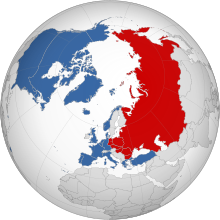
Operation Unthinkable was the name given to two related possible future war plans developed by the British Chiefs of Staff Committee against the USSR during 1945. The plans were never implemented. The creation of the plans was ordered by British Prime Minister Winston Churchill in May 1945 and developed by the British Armed Forces' Joint Planning Staff in May 1945 at the end of World War II in Europe.[1]
One plan assumed a surprise attack on the Soviet forces stationed in Germany to impose "the will of the United States and British Empire upon Russia".[2] "The will" was qualified as "a square deal for Poland",[3] which probably meant enforcing the recently signed Yalta Agreement. The planners decided that without American help, the British would probably fail. The assessment, signed by the Chief of Army Staff on 9 June 1945, concluded: "It would be beyond our power to win a quick but limited success and we would be committed to a protracted war against heavy odds".[2] The code name was now reused instead for a second plan, which was a defensive scenario by which the British were to defend against a Soviet drive towards the North Sea and the Atlantic Ocean after the withdrawal of the American forces from the Continent. When the Labour Party acquired power by the 1945 general election, it ignored the draft plan.
The study became the first Cold War-era contingency plan for war against the USSR.[4] Both plans were top secret and were not made public until 1998,[5] although Soviet spy Guy Burgess had revealed some details to them at the time.[6]
- ^ Todman, Daniel (2017). Britain's War: A New World, 1942-1947. Oxford University Press. ISBN 978-0-19-065848-9.
- ^ a b ""Operation Unthinkable"". British War Cabinet, Joint Planning Staff. 22 May 1945 – via The National Archives (United Kingdom).
- ^ Cite error: The named reference
OpRep-1was invoked but never defined (see the help page). - ^ Costigliola 2011, p. 336.
- ^ Gibbons 2009, p. 158.
- ^ Lownie 2016, p. 148.